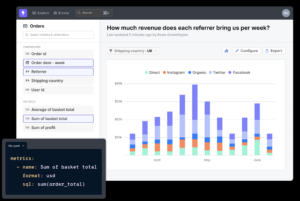
Lightdash Emerges to ‘Fix’ The Data Analyst Workflow

(Rymden/Shutterstock)
The company behind Lightdash, a new open source data analytics and exploration tool designed around dbt and frequently compared to Looker, today announced a seed round of funding worth $8.4 million as well as the launch of a beta of its new cloud offering.
Lightdash, which is the name of the company and the product, emerged from Y Combinator’s S20 batch as a tool named Hubble designed to test the quality of data in data warehouses, such as the freshness of timestamps and the cardinality of strings.
Many data transformations today are written in a SQL dialect using dbt (which previously referred to Data Built Tool), and so it was natural to target the growing base of dbt users with graphical tools designed to speed up and automate some of that work. As companies rely more on data, they’re finding the costs of poor data quality are rising, and the developers wanted to target that segment of the data analytics workflow.
Over time, the London-based developers behind Hubble broadened their focus to serving as the main GUI front-end for data projects driven with dbt. Lightdash, as the product was renamed, is “BI for the whole team,” as the company proclaims on its website. Advanced users can work with SQL to query data warehouses (it’s pre-wired to work with popular warehouses like Snowflake, BigQuery, and Redshift, among others), while less technical folks can happily build charts, dashboards, and metrics in a GUI environment.
In addition to providing the front-end interface, Lightdash also provides governance capabilities and guardrails to help teams of analysts keep their data on the straight and narrow. One of the problems with analytics in a team environment is different members using different source data and creating different derived metrics, which often results in the wrong numbers being used and hence, poor decisions. Looker, with its LookML modeling language, took a big step towards getting teams working from the same page and the same data, and this is why Lightdash is often compared to Looker, which Google acquired in 2019 for $2.6 billion.
Solving this data dilemma has been the goal of Lightdash for the past year and a half, says Hamzah Chaudhary, the co-founder and CEO of Lightdash.
“In May 2021, we started working on Lightdash as an open-source tool to visualise your dbt project and store all your business logic in dbt,” Chaudhary writes in a blog post today. “We loved a lot of the tools that were already available to us as data practitioners, but felt like we were being let down at the BI layer, which just happens to be where the rubber hits the road for the rest of the business too. So we set out to build Lightdash–the best way for modern data teams to build in BI.”
As an open source project, Lightdash has found some success. According to Chaudhary, the project has been adopted by companies like BeautyPie, Accenture, and Warner Media. A query runs in Lightdash every 30 seconds, he says.
That success has attracted some additional venture funding. In addition to the previously unannounced $2.4 million round led by Moonfire Ventures, the company today announced $6 million led by Accel.
The company plans to make it easier to get Lightdash up and running with the launch of Lightdash Cloud, a fully managed version of Lightdash. The service, which is in beta, will provide access to Lightdash experts and certain uptime and response SLAs, and will be priced at $400 per month, but users can start for free.
Related Items:
dbt Seeks to Modernize the Data Experience with Series D
What Is An Analytics Engineer and When Do You Need One?































